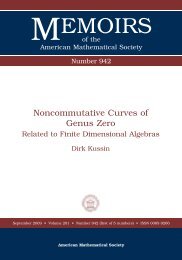University of Paderborn Department of Mathematics Diploma Thesis ...
University of Paderborn Department of Mathematics Diploma Thesis ...
University of Paderborn Department of Mathematics Diploma Thesis ...
You also want an ePaper? Increase the reach of your titles
YUMPU automatically turns print PDFs into web optimized ePapers that Google loves.
66 CHAPTER 3. OPERATIONS ON STABLE IDEALSPro<strong>of</strong> <strong>of</strong> Claim 1. By the algorithm described in Remark 3.31, we successively contract thelargest monomial generators <strong>of</strong> L H (with respect to the lexicographic order) with the lastvariable x n−1 , until there is only one monomial generator left, which contains x n−1 . Let mbe the first monomial in L H with respect to the lexicographic order, such that m containsmlast variable x n−1 . Then we contract in L H , which provides some ideal L conHx .n−1Assume L conH is not a lexicographic ideal. Since the only effect <strong>of</strong> the contraction <strong>of</strong> min L H is removing m from the set <strong>of</strong> minimal generators and includingx n−1mx n−1into the set <strong>of</strong>minimal generators, L conH is not a lexicographic ideal, if [Lconsubset <strong>of</strong> [R] deg m−1 . Hence, there is at least one monomial ˜m ∈ [R] deg m−1 with ˜m >H ] deg m−1 is not a lexicographicmand ˜m /∈ [L conH ] deg m−1. It follows ˜m · x n−1 > m. Since m ∈ [L conH ] deg m and [L conH ] deg mis a lexicographic subset <strong>of</strong> [R] deg m , we obtain ˜m · x n−1 ∈ [L conH ] deg m, and in particular˜m·x n−1 ∈ L H . Therefore, there is a minimal monomial generator ¯m·x n−1 in L H , such that˜m · x n−1 is divisible by ¯m · x n−1 . Note that the monomial generator contains x n−1 , sinceotherwise it would divide ˜m, which is a contradiction to the fact that ˜m /∈ [L conH ] deg m−1.Furthermore, we have deg( ¯m · x n−1 ) ≤ deg( ˜m · x n−1 ) = deg m. But this contradicts thefact that we have chosen m to be the first monomial generator in L H with the last variablex n−1 .It follows that L conHx n−1is a lexicographic ideal. Iteration <strong>of</strong> the process proves that any <strong>of</strong>the contractions performed successively due to Remark 3.31 provides a lexicographic ideal.Since any <strong>of</strong> the expansions described in Remark 3.31 to take L H to J only increases theexponent <strong>of</strong> the last and only monomial generator containing the last variable x n−1 , theseexpansions will always give a lexicographic ideal. It follows that J is a lexicographic ideal,which proves Claim 1.Since we know that J is a lexicographic ideal with only one minimal monomial generatorcontaining x n−1 , set m := x arn−r−1 · x a r−1n−r · x a r−2n−r+1 · . . . · x a 1n−2 · x a 0n−1 to be this monomialwith suitable r, a 0 , a 1 , . . . , a r−2 , a r−1 , a r .Claim 2. The set <strong>of</strong> minimal generators <strong>of</strong> J is given by{x 0 , x 1 , . . . , x n−r−2 ,x ar+1n−r−1,x arn−r−1 · x a r−1+1n−r ,x arn−r−1 · x a r−1n−r · x a r−2+1n−r+1 , . . . ,x arn−r−1 · x a r−1n−r · x a r−2n−r+1 · . . . · x a 2n−3 · x a 1+1n−2 ,x arn−r−1 · x a r−1n−r · x a r−2n−r+1 · . . . · x a 1n−2 · x a 0n−1 = m}.Pro<strong>of</strong> <strong>of</strong> Claim 2. First we show that each <strong>of</strong> the monomials in the above set is containedin J. Then, since J is stable and lexicographic, we will be able to conclude that all
















